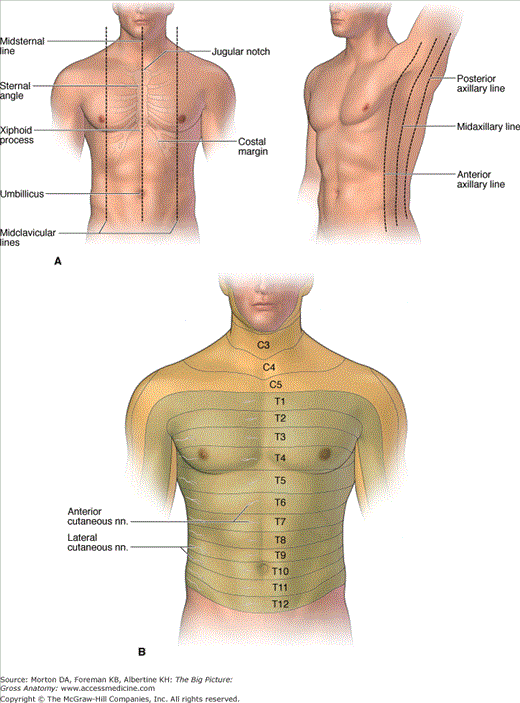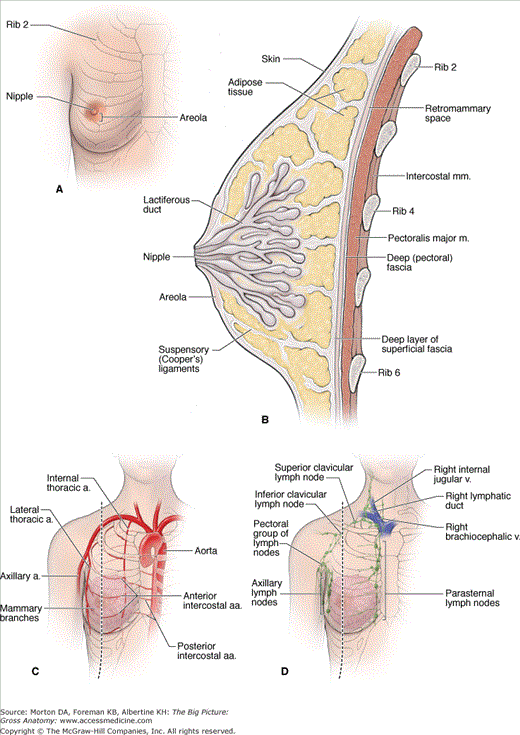Surface Anatomy
The clavicle and parts of the thoracic cage provide prominent surface landmarks. Directional terms are used to help orient the reader to the thorax. The cutaneous innervation of the anterior portion of the thoracic wall is from lateral and anterior cutaneous nerves via ventral rami, forming a segmental dermatomal pattern.
Palpable bony landmarks and reference lines are important to use for anatomic orientation as well as a guide to locate deep structures. You should become familiar with the following structures of the anterior portion of the thoracic wall (Figure 2-1A; Table 2-1):
- Clavicles. Course transversely along the superior portion of the chest wall from the manubrium to the acromion of the scapula and, therefore, are easily palpable. However, the clavicle, overly rib 1, which makes rib 1 impalpable.
- Jugular notch of the sternum. Located between the medial ends of the clavicles.
- Sternal angle (of Louis). Articulation between the manubrium and sternal body. The sternal angle serves as the location for the articulation of rib 2 with the sternum at the T4–T5 vertebral level. The sternal angle is often visible and palpable and serves as an important surface landmark for several underlying structures.
- Xiphoid process. An inferior pointed projection of the sternal body. The xiphoid process lies at the level of the T9 vertebral body.
- Costal margins. Formed by costal cartilages 7–10.
Vertebral Level | Landmark |
|---|---|
T2 | Jugular notch |
T3 | Base of spine of scapula; junction of brachiocephalic veins to form superior vena cava |
T4 | Sternal angle (second costal cartilage, tracheal bifurcation, beginning and end of aortic arch, beginning of thoracic aorta, azygos vein arch over right primary bronchus, thoracic lymphatic duct crosses from right to left side of thoracic cavity) |
T7 | Inferior angle of scapula |
T8 | Caval hiatus of diaphragm |
T9 | Xiphoid process |
T10 | Esophageal hiatus of diaphragm |
T12 | Aortic hiatus of diaphragm |
The following imaginary vertical lines provide anatomic and clinical descriptions for orientation (Figure 2-1A):
- Midsternal line. Dropped through the center of the sternum. It is a component of the median plane.
- Midclavicular line. Dropped through the middle of the clavicle, just medial to the nipple.
- Anterior axillary line. Dropped through the anterior axillary fold formed by the pectoralis major muscle.
- Midaxillary line. Dropped through the middle of the axilla, along the lateral border of the thoracic wall. The midaxillary line is bounded by the anterior axillary fold (pectoralis major muscle) and the posterior axillary fold (latissimus dorsi muscle).
- Posterior axillary line. Dropped through the posterior axillary fold formed by the latissimus dorsi muscle.
Lateral and anterior cutaneous branches of the intercostal nerves innervate the skin of the thorax in a segmental pattern. The following notable landmarks are helpful to identify the following dermatomes (Figure 2-1B; Table 2-2):
- Nipple–T4 dermatome
- Xiphoid process–T6 dermatome
- Umbillicus–T10 dermatome
The Breast
The breast contains the mammary gland, a subcutaneous gland that is specialized in women for the production and secretion of milk and, as a result, enlarges during the menstrual cycle and during pregnancy. The mammary gland overlies ribs 2 to 6 between the sternum and midaxillary line. The mammary gland is located within the superficial fascia, surrounded by a variable amount of adipose tissue that is responsible for the shape and size of the breast. The breast lies on the deep fascia related to the pectoralis major and serratus anterior muscles. The retromammary space is a layer of loose connective tissue that separates the breast from the deep fascia and provides some degree of breast mobility over underlying structures. A prolongation of each breast, called the axillary tail, extends superolaterally along the inferior border of the pectoralis major into the axilla.
Each gland consists of 15 to 20 radially aligned lobes of glandular tissue. A lactiferous duct drains each lobe (Figure 2-2A and B). The lactiferous ducts converge and open onto the nipple. The nipple is positioned on the anterior surface of the breast and is surrounded by a somewhat circular hyperpigmented region, the areola. Sebaceous glands within the areola enlarge to form swollen tubercles during pregnancy as the areola darkens. Small collections of smooth muscle located at the base of the nipple may cause erection of the nipple when breast feeding or sexually aroused.
Fibrous and adipose tissues occupy the spaces between the lobes of glandular tissue. To help support the weight of the breast, strong fibrous bards called suspensory (Cooper’s) ligaments separate the lobes and attach between the dermis and deep layer of the superficial fascia.
To simplify an understanding of vascular supply and lymphatic drainage, the breast’s anatomy can be best understood by division into medial and lateral regions (Figure 2-2C and D).
- Medial region of the breast. Derives its blood supply from perforating branches of the internal thoracic artery (medial mammary branches from the second through fourth intercostal spaces) and is drained by internal thoracic veins. Lymphatic vessels exiting the medial side of the breast drain into the parasternal lymph nodes, which lie beside the internal thoracic veins.
- Lateral region of the breast. Derives its blood supply from branches of the lateral thoracic artery (axillary artery origin) and mammary branches from the 2nd through the 5th posterior intercostal arteries (thoracic aorta origin) and is drained by the lateral thoracic and intercostal veins, respectively. The lymphatic vessels draining the lateral side of the breast lead primarily into the pectoral group of axillary lymph nodes and account for most of the lymph drained from the breast. Figure 2-2D shows lymph from the right breast draining into the right lymphatic duct at the junction of the right brachiocephalic vein. In contrast, the left breast (not shown) drains into the thoracic lymphatic duct at the left brachiocephalic vein junction.
Some breast lymphatics drain into the infraclavicular group of axillary nodes, as well as the supraclavicular group of deep cervical nodes.
 Breast augmentation is a procedure that is performed to enhance the shape and size of the breast. The procedure is frequently performed for cosmetic reasons or for breast reconstruction. The implant (filled with saline or silicone) may be inserted from various incision sites. Regardless of the incision site, the implant is placed in one of two areas, either subglandular (between the pectoralis major muscle and the mammary gland) or submuscular (deep to the pectoralis major muscle).
Breast augmentation is a procedure that is performed to enhance the shape and size of the breast. The procedure is frequently performed for cosmetic reasons or for breast reconstruction. The implant (filled with saline or silicone) may be inserted from various incision sites. Regardless of the incision site, the implant is placed in one of two areas, either subglandular (between the pectoralis major muscle and the mammary gland) or submuscular (deep to the pectoralis major muscle).
 Most breast adenocarcinomas are lactiferous duct carcinomas that begin as painless masses, most commonly in the upper lateral quadrant.
Most breast adenocarcinomas are lactiferous duct carcinomas that begin as painless masses, most commonly in the upper lateral quadrant.
The sensory innervation of the skin overlying the breast has a segmental arrangement and is supplied by branches of the 2nd through 7th intercostal nerves. However, physiologic changes in the breast are not mediated by nerves but by circulating hormones. For example, high prolactin levels result in milk production, and oxytocin causes the milk “letdown” reflex.





